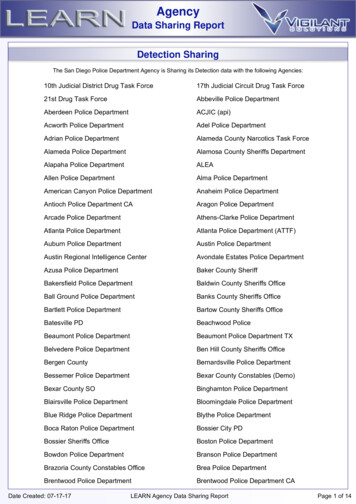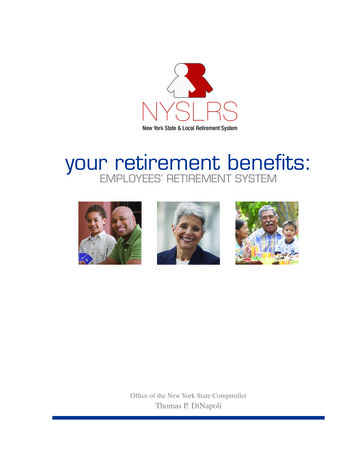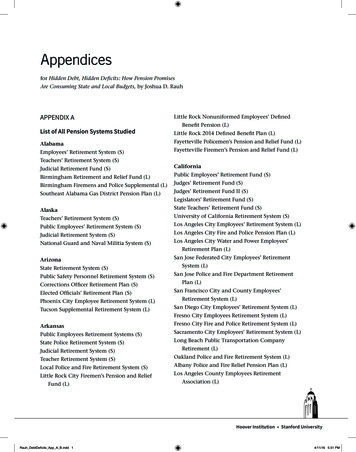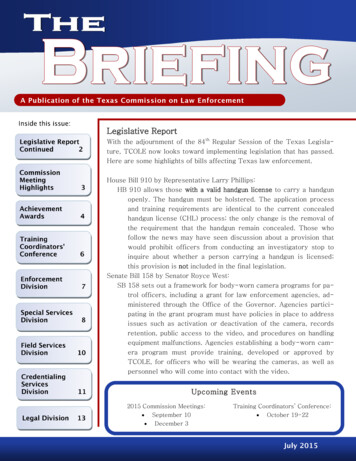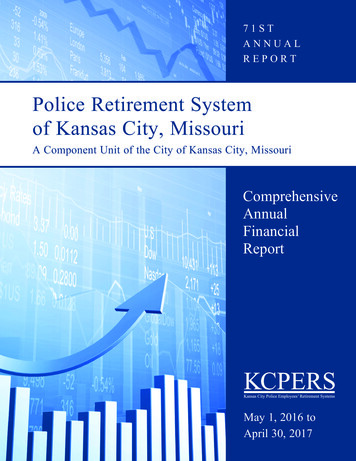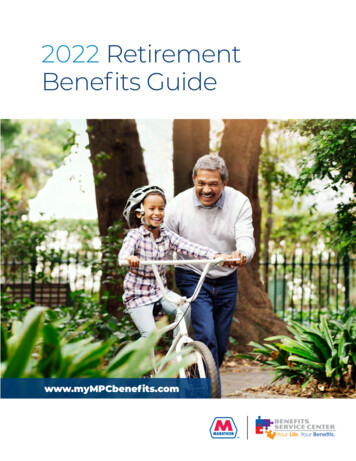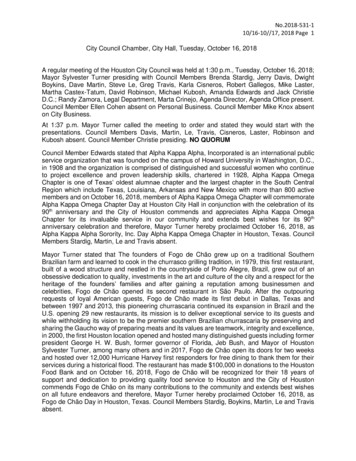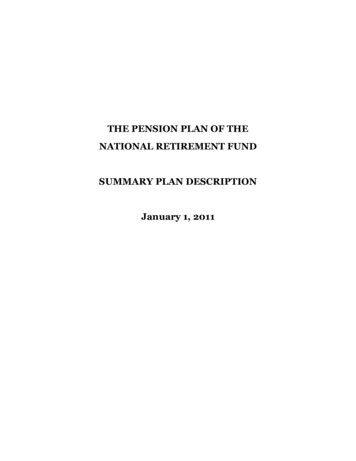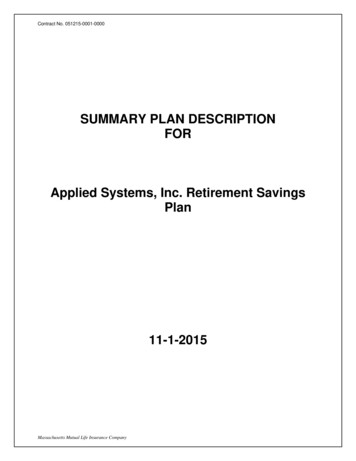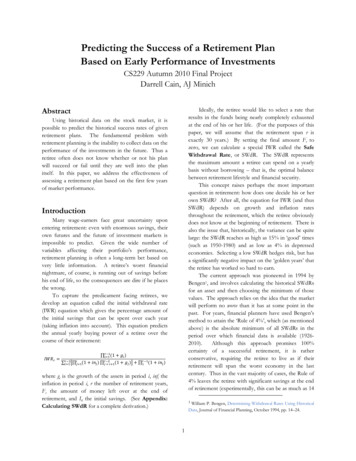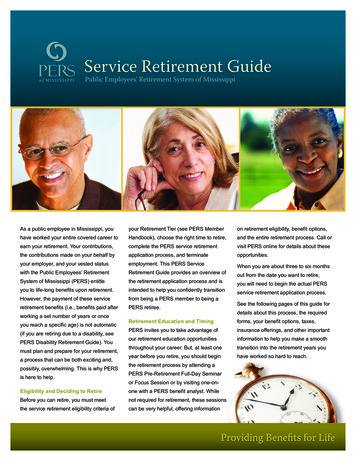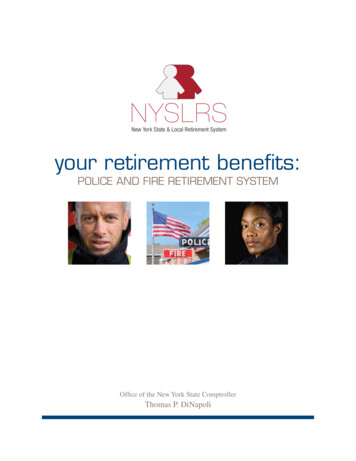
Transcription
Office of the New York State ComptrollerThomas P. DiNapoliNYSLRSNew York State & Local Retirement System110 State Street, Albany, New York 12244-0001your retirement benefits:POLICE AND FIRE RETIREMENT SYSTEMOffice of the New York State ComptrollerThomas P. DiNapoli
Office of the New York State ComptrollerThomas P. DiNapoliNYSLRSNew York State & Local Retirement System110 State Street, Albany, New York 12244-0001your retirement benefits:POLICE AND FIRE RETIREMENT SYSTEMOffice of the New York State ComptrollerThomas P. DiNapoliZO1829 (Rev. 9/18)1
table of contentsA Message from State Comptroller Thomas P. DiNapoli. 3Your Membership in the Retirement System. 5Service Credit. 9Final Average Salary. 15Retirement Plans. 23Preparing for Your Retirement. 41Applying for Your Service Retirement Benefit. 53After You Retire. 59Disability Benefits. 65Death Benefits . 87Survivor’s Benefit Program. 97Your Obligations. 99Retirement System Forms . 101ZO1829 (Rev. 9/18)2
A MESSAGE FROM STATE COMPTROLLERT homas P. DiNapoliDear Member:This book describes your New York State and Local Retirement System (NYSLRS) benefits and can bea valuable resource — especially as you approach retirement. We also offer other resources to help youunderstand your benefits so you can successfully plan for retirement.Use these resources to get details about your NYSLRS account and your benefits:nn Sign in to Retirement Online. It’s a convenient and secure way to review your NYSLRS benefits.You can also use Retirement Online to update your address and your beneficiaries and to applyfor a loan. Register or learn more at www.osc.state.ny.us/retire.nn Review your Member Annual Statement, which provides your NYSLRS membership detailsto you every summer.nn Request a formal pension benefit estimate when you are within 18 months of retirement.Visit our website (www.osc.state.ny.us/retire) for these general pre-retirement planning resources:nn Read your retirement plan booklet and other publications that outline and explain your benefits.nn Use our online Benefit Projection Calculator. Most members can use it to estimate what theirpensions will be when they retire.nn Subscribe to our blog, New York Retirement News, like us on Facebook and follow us onTwitter for tools, quick tips and information on a variety of retirement topics.nn Sign up for E-News, our monthly email newsletter, for the latest NYSLRS news. It includesa special section dedicated to pre-retirement planning.I am joined by a staff of dedicated professionals who are as committed as I am to helping you makeinformed decisions about your future. I encourage you to contact us with any questions you might have.Sincerely,Thomas P. DiNapoliState ComptrollerZO1829 (Rev. 9/18)3
This page intentionally left blank.ZO1829 (Rev. 9/18)4
YOUR MEMBERSHIP IN THEr etirement systemAs a public servant in New York State and a member of one of the world’s largestpublic pension systems, you are covered by a retirement plan that provides importantbenefits. Whether you have just joined or have been a member your entire career, it isimportant to know about those benefits.The New York State and Local Retirement System (NYSLRS) is a defined benefit plan.Your pension will be based on factors such as your tier, retirement plan, service credit,final average salary (FAS) and age at retirement.This publication explains your rights and obligations as a member. It clarifies thefactors that affect your retirement benefits and provides you with examples of howthose benefits are determined. It also takes you step-by-step through the retirementprocess and provides information about a variety of post-retirement matters.Please contact us whenever you have questions about your benefits.ZO1829 (Rev. 9/18)5
Stay InformedYour retirement benefits are an important partof a solid financial plan. They can help you andyour bene ficiaries achieve financial security inretirement or in the event of disability or death.Use these tips to help you understand yourbenefits and stay informed.nn Attend a pre-retirement presentation tolearn about the retirement process anddiscuss post-retirement issues. At youremployer’s request, we offer these presentations designed for members withinfive years of retirement eligibility.nn Register for Retirement Online, a convenient and secure way to review yourbenefits and conduct transactions in realtime. In many cases, you’ll be able to useRetirement Online instead of mailingforms or calling NYSLRS. Members canview benefit information, update contactinformation, view and update beneficiaries and apply for a loan. Learn more omers.php.nn Make an appointment to visit any ofour consultation sites (www.osc.state.ny.us/retire/consultation site offices/index.php), where you can meet withan information representative to discussspecial concerns or request specificinformation.nn Subscribe to our blog, New York Retirement News (www.nyretirementnews.com), where you’ll find tools to helpyou understand your benefits, as wellas important Retirement System news.nn Like us on Facebook (www.facebook.com/nyslrs) and follow us on Twitter(www.twitter.com/nyslrs) for quick tipsand updates on a variety of retirementtopics.nn Notify us if your mailing address changes.This is especially important if you leavepublic employment before you are eligible to retire.nn Contact us (www.contactNYSLRS.com) ifyou have questions about your benefits.Email: www.emailNYSLRS.com;Call: -866-805-0990, or1518-474-7736 in the Albany,New York area; orMail: NYSLRS110 State StreetAlbany, NY 12244-0001nn Sign up for E-News, our email newsletter hp), for the latest NYSLRSnews and information dedicated to preretirement planning.nn Read your member newsletter, TheSentinel, for current retirement information and updates on your benefits.nn Review your Member Annual Statementcarefully and notify us of any errorspromptly.nn Visit our website (www.osc.state.ny.us/retire/index.php) frequently to learnabout your benefits, download forms,read informative booklets and brochures,and get tips on preparing for retirement.ZO1829 (Rev. 9/18)6
Retirement ConsultationRetirement consultations are available atlocations throughout the State. To schedulean appointment, contact our Call Center tollfree at 1-866-805-0990, or 518-474-7736 inthe Albany, New York area.Appointments are needed for individualconsultations at all sites. However, with theexception of our New York City site, membersdo not need an appointment to drop off forms,pick up information or have something notarized.Our Albany office hours are 8:30 am – 4:30 pm.Office hours at all other sites are 9:00 am – noonand 1:00 pm – 4:00 pm. All sites are closed onlegal holidays.When visiting any of our sites, please bringphoto identification and any recent RetirementSystem correspondence. If you require specialaccommodations, contact our Call Center at leasttwo weeks in advance of your visit and we willmake a reasonable effort to meet your needs.Consultation Site OfficesCity/ VillageAddressMonthly Visiting DaysAlbany110 State St.Every Business DayBinghamtonBinghamton State Office Building44 Hawley St., Room 606Every TuesdayBuffaloWalter J. Mahoney State Office Building65 Court St., Room 500Every Business DayCantonSUNY at Canton (off Route 68)Campus Center, 2nd FloorFirst ThursdayHauppauge330 Motor Pkwy., Suite 107Every Business DayMiddletownHudson Valley DDSO42 Rykowski Ln.Second & Fourth ThursdayNew York City59 Maiden Ln., 30th FloorEntrance located between William St. and Nassau St.Every Tuesday & WednesdayPlattsburghCounty Center, County Clerk’s Office137 Margaret St., 1st FloorFirst & Third ThursdayPomona50 Sanatorium Rd., 7th FloorFirst & Third FridayPoughkeepsieEleanor Roosevelt State Office Building4 Burnett Blvd.Second & Fourth FridayRochesterNYS DOT Building1530 Jefferson Rd., HenriettaEvery ThursdaySyracuse620 Erie Blvd. West, Suite 113Every FridayUticaUtica State Office Building207 Genesee St., Ground FloorFirst, Second, Third & Fourth MondayWatertownJefferson County Human Services Building250 Arsenal St., Lower Level Conference RoomFirst WednesdayWhite PlainsClarence D. Rappleyea Building123 Main St., 1st FloorEvery WednesdayNOTE: Always check our website (www.osc.state.ny.us/retire/consultation site offices/index.php) for themost current consultation site schedule, as locations and monthly visiting days can change.ZO1829 (Rev. 9/18)7
Your Membership TierTier ReinstatementMembers are categorized into different groupsor tiers based on their date of membership in theRetirement System. There are five tiers in theNew York State and Local Police and Fire Retirement System (PFRS). Tier status determines thefollowing, but is not limited to:If you had a previous membership in thisSystem, or any of the following public retirement systems, your service may be recreditedand your date of membership and tier restored.However, an earlier tier of membership does notalways result in a better benefit. Please contactus regarding your membership and the potentialfor reinstatement.nn Contribution requirements;nn Benefit eligibility;nn Service crediting;nn New York State and LocalEmployees’ Retirement Systemnn Formula used to calculate yourfinal average salary;nn New York State Teachers’Retirement Systemnn Loan provisions;nn Vesting requirements;nn New York City Employees’Retirement Systemnn Death benefit coverage; andnn New York City Police Pension Fundnn Formula used to calculate yourretirement benefit.nn New York City Teachers’Retirement SystemYou Are In:If You Joined:Tier 1Before July 31, 1973Tier 2July 31, 1973 through June 30, 2009Tier 3July 1, 2009 through January 8, 2010*Tier 5January 9, 2010 through March 31, 2012Tier 6April 1, 2012 or afternn New York City Board ofEducation Retirement Systemnn New York City Fire DepartmentPension Fund* PFRS members who joined July 1, 2009 throughJanuary 8, 2010, and did not elect to be coveredby Article 22 (opt into Tier 5), can be covered byArticle 11 or Article 14 benefits, depending on theirretirement plan election. There is no Tier 4 in theNew York State Police and Fire Retirement System.ZO1829 (Rev. 9/18)8
service credit As a member, you earn service credit for your public employment while on the payrollof a participating employer in the Retirement System. Your service credit is a keyfactor in determining your eligibility and calculating your death benefits, vested rights,service retirement, disability retirement and member loans. Since your benefits aredirectly related to your service credit, it is important to make sure you have credit forall your allowable service.Members of the New York State and Local Police and Fire Retirement System whoseemployer has adopted one or more special plans should be aware that not all servicein public employment is creditable under these plans. Please refer to the “RetirementPlans” section beginning on page 23 to find out what service is creditable under yourspecial plan.ZO1829 (Rev. 9/18)9
Service CreditingYour employer sets the number of hours thatmake up a standard workday. Generally, 260workdays per year, as reported to us by youremployer(s), constitute full-time credit.A full year of service credit is given forfull-time service. Part-time service is generallyprorated, and you cannot earn more than oneyear of service credit within any one year, evenif you work for multiple employers.Credit is not given for leaves of absencewithout pay or for any period in which you donot receive a salary. There may be exceptionsif you are on sick leave at half-pay or receivingworkers’ compensation benefits.The date you are eligible to retire depends onyour tier:Tier 1Full vested benefit as early asthe first of the month following your55th birthday.Tiers 2 and 3(Article 11)covered bya regularretirement planFull vested benefit at age 62.Tiers 2 and 3(Article 11)covered bya specialretirement planFull vested benefit at age 55.Tier 3(Article 14)Full vested benefit at your earlyretirement age (the age atwhich you would have completed20 years of service credit).VestingYou are eligible for a vested retirementbenefit if you leave public employment beforeretirement age and you have met the minimumservice requirement. Tier 1, 2 and 3 membersmust have five years of credited member service,and tier 5 and 6 members must have ten years.When you reach retirement age, you will beentitled to a retirement benefit based on yourservice and earnings when you were an activemember.Early retirement with a reducedbenefit as early as the first of themonth following your 55th birthday.Early retirement with a reducedbenefit as early as the first of themonth following your 55th birthday.Tier 5 coveredby a regularretirement planFull vested benefit at age 62.Tier 5 coveredby a specialretirement planFull vested benefit at age 55.Tier 6Full vested benefit at age 63.Early retirement with a reducedbenefit as early as the first of themonth following your 55th birthday.To receive your vested benefit at the earliestpossible date, file a retirement applicationwithin 90 days before your eligibility date. If wereceive your retirement application after youreligibility date, your vested retirement will beeffective on the date the application is received.Remember, it is up to you to file a retirementapplication when you become eligible and wishto receive your benefits.ZO1829 (Rev. 9/18)10
Unused, Unpaid Sick LeaveUnused, unpaid sick leave may be added toyour credited service and used in your benefitcalculation if you are a New York State employeeor if your employer has chosen to offer theop tional sick leave benefit provided by Section341(j) of Retirement and Social Security Law(RSSL). To be eligible for this benefit, you mustretire directly from public service or within ayear of separating from service.The additional credit is determined by dividing your total unused, unpaid sick leave days by260. If applicable, up to 165 days (.63 of a year)of unused, unpaid sick leave may be credited.Members in certain negotiating units may have upto 200 days (.77 of a year) of unused, unpaid sickleave credited. Check your Member Annual Statement to see if your employer offers this benefit.Credit for your unused sick leave at retirementcannot be used to:nn Qualify for vesting. For example, if youhave four years and ten months of servicecredit and you need five years to be vested,your sick leave credit cannot be used toreach the five years.nn Qualify for a better retirement benefitcalculation. For example, if you have19½ years of service credit but yourpension will improve substantially ifyou have 20 years, your sick leave creditcannot be used to reach the 20 years.nn Increase your pension beyond themaximum amount payable under yourretirement plan.nn Meet the service credit requirement toretire under a special 20- or 25-year plan.ExampleFor a member whose full-time day is 8 hours# hours unused sick leavefull-time hours per day # days additionalservice credit1320 hours8 165 days additionalservice credit# days additional service credit260 additionalservice credit165 days260 .63 of a year additionalservice creditZO1829 (Rev. 9/18)11
Credit For Your Past ServiceTo ApplyLegislative changes in 2000 allow for thecrediting of most previous public employment.Some previous service, however, may not becreditable under certain retirement plans andmay not increase your retirement benefit. Pleasereview the information regarding allowable servicefor your retirement plan on pages 23 through 39.Submit a Request to Purchase Service Credit(Including any Military Service) (RS5042) form.See page 102 for a description and a link to theform on our website. You can also submit a letter.Include the complete details of the service you’dlike credited and mail it to:nn Prior Service — Prior service is anyperiod of time you received salary froma public employer before that employerelected to participate in NYSLRS.NYSLRSMember and Employer Services Bureau110 State StreetAlbany, NY 12244-0001.nn Service Before Your Date ofMembership — You may receive creditfor working for a participating publicemployer in New York State before youjoined NYSLRS (including Comprehensive Employment and Training Act(CETA) service).nn Service From a Previous Membership —If you previously were a member ofNYSLRS, or another public retirementsystem in New York State, your servicemay be recredited and your date ofmembership and tier restored.Note: In most cases, service credit obtainedfrom membership in another retirementsystem would not be allowable under aPFRS special plan.nn Military Service — You may be ableto get retirement credit for service in theU.S. armed forces.ZO1829 (Rev. 9/18)12
Military Service CreditAll Types of Service CreditTo find out if you qualify, please send us acopy of your Certificate of Release or Dischargefrom Active Duty (DD-214) along with yourwritten request. If your military records weredestroyed in the 1973 fire at the NationalPersonnel Records Center (NPRC), we willalso accept a certificate of military service.We will send you a letter indicating theamount of previous service credit you areeligible to receive and any applicable cost.Some things to remember:You can request a copy of your records from theNational Archives and Records Administration:Website: Fax: 314-801-9195Address: National Personnel Records Center1 Archives DriveSt. Louis, MO 63138-1002Veterans who have left the armed forces,but maintain reserve status, should contact thereserve component of the appropriate branchof service.Veterans currently in the National Guardshould contact the Adjutant General’s Officeof New York State. In most cases, recentlydischarged National Guard members will notbe able to get their military records from NPRCuntil six months after discharge because of therequired processing.For more information about getting creditfor your military service, visit our MilitaryService Credit page at e-credit.php.nn Even if you included past service onyour membership application, you mustmake this formal request to receivecredit for it.nn Make your request well before youexpect to retire. This gives us sufficienttime to get salary and service recordsfrom your employer(s), and it allowsyou ample time to pay for the credit,if necessary.nn Tier 2, 3, 5 and 6 members need twoyears of service credit in their currentmemberships before they can claimcredit for previous service.nn Members may need at least five yearsof service credit in their current memberships before they can claim creditfor military service. It depends on theparticular statute governing the service.nn To establish eligibility for a vested retirement benefit, you must request creditfor your previous service while on thepayroll of a participating employer.If you receive notice of an associatedcost after you’ve left payroll, you mustpay the full amount within 30 days.ZO1829 (Rev. 9/18)13
Paying for Your CreditThere will generally be a cost to claim creditfor your previous service.nn Mandatory Service – If you are coveredby a plan that requires contributions(Tier 5 and 6 members), and if no orinsufficient contributions were made tothe Retirement System, you may owemandatory payments associated withyour past service. In that case, we notifyyou of the amount due. You may makea single lump sum payment to cover thecost for this service, or you may requestthat we notify your employer to beginpayroll deductions to cover the cost.nn Optional Service – If you are seekingcredit for military service or public employment before your membership date,any associated payments are optional.Your cost letter will provide paymentoptions and a due date, after which yourcost would have to be recalculated. Thecost accumulates 5 percent interest compounded annually.Before purchasing service credit, please note:Credit for past service, including service thatmay qualify you for an earlier tier of membership, does not always result in a better benefit.Please review your options carefully before making a decision, and contact us (www.contactNYSLRS.com) with any questions you have.You may also want to use our online benefitprojection calculator at -pension.php.Try calculating your benefit with and withoutthe available credit to help you determine ifmaking the purchase is right for you.If there is a cost to secure credit for optionalpast service, there are three ways you canmake payment:1. A single lump sum to cover the entirecost of the past service;2. Payroll deductions (you may make add itional payments if you want to pay offthe balance sooner); or3. A trustee-to-trustee transfer from one ofthe allowable plans below (for optionalservice only).408(a) or 408(b)Individual Retirement Account403(a) Annuity Plan403(b) Tax-Sheltered Annuity401(a) or 401(k) Qualified DefinedBenefit or Contribution Plan457 Governmental DeferredCompensation PlanTransfers from Roth IRAs, inherited IRAs orinherited Roth IRAs are not permitted.NOTE: If you decide on payroll deductions,the payment period cannot exceed the amountof service credit being purchased. For example,if you are purchasing three years of servicecredit, payroll deductions can be made for upto three years, or until your date of retirement,whichever comes first. At the time of retirement,the total cost must be paid in full or you willreceive credit only for that part of your previousservice that was paid for. Any mandatory servicethat has not been paid for by your date of retirement will cause a permanent reduction to yourmonthly benefit.ZO1829 (Rev. 9/18)14
final average salary Your final average salary (FAS) is an important factor in the calculation of your retirementbenefit. For all PFRS members in Tiers 1 through 5, FAS means the average of the threehighest consecutive years of earnings in covered public employment. For Tier 6 members,it is the average of the five highest consecutive years of earnings. This is usually the lastyears of employment immediately before retirement. However, if there is a consecutivethree- or five-year period* of usable earnings earlier in your career that would result in ahigher FAS, we will use that higher FAS to calculate the benefit. We do the FAS comparisonautomatically at the time of your retirement. The earnings used in the FAS calculationmay be subject to certain limitations based on the date you joined the Retirement System.Some employers have also adopted an additional one-year FAS benefit for theiremployees. In this calculation, the last 12 months of regular compensation must be used.* Not always a calendar or fiscal year.ZO1829 (Rev. 9/18)15
ONE-YEAR FINAL AVERAGE SALARYSections 302(9)(d) and 443(f)If your employer has adopted this benefit,your retirement pension will be calculated using a one-year FAS, unless the three-yearFAS provides a higher benefit.The one-year FAS includes only the regularcompensation earned during the 12 monthspreceding retirement. The calculation of a oneyear FAS can include, but is not limited to,the following types of payments:LimitationsThe earnings used in the calculation of theone-year FAS cannot exceed the earnings inthe previous 12-month period by more than20 percent. Any amount over 20 percent willbe excluded from the calculation.Here’s an example of a one-year FAScalculation:Examplenn Regular salary;nn Overtime;*nn Holiday pay;nn Compensatory overtime;* andnn Longevity payment.The following types of payments are notconsidered regular compensation and will notbe included in the one-year FAS calculation:ActualEarningsLimitEarningsAllowedYear 1: 106,100 86,200 1.2 103,440 103,440Year 2: 86,200Note: The earnings in Year 1 exceed the earningsof the previous 12 months by more than 20 percent.The one-year FAS would be limited to 103,440.nn Unused sick leave;nn Unused vacation;nn Payment made as a result of workingyour vacation;A three-year FAS would also be calculatedand compared to the one-year FAS. The greaterof the two calculations (usually the one-yearFAS) would be used.nn Termination pay;nn Payments made in anticipation ofretirement;nn Lump sum payment for deferredcompensation; andnn Payments made for time not worked.* For Tier 5 members, the amount of overtime andcompensatory overtime that can be included inyour FAS calculation is limited to 15 percent ofyour salary.ZO1829 (Rev. 9/18)16
THREE-YEAR FINAL AVERAGE SALARYA three-year FAS is the average of the wagesearned during any three consecutive years ofservice when earnings were highest. This isusually the last three years of employment.The FAS calculation can include, but is notlimited to, the following types of paymentsearned during the FAS period:Here is an example of a three-year FAS calculation for a member who joined before June 17,1971. Members who joined before this date arenot subject to earnings limitations.ExampleEarningsnn Regular salary;Year 1: 106,100nn Holiday Pay;Year 2: 86,200nn Overtime;*Year 3: 84,300nn Compensatory overtime;* 276,600 3 92,200 FASnn Longevity; andnn Vacation pay (up to 30 days for Tier 1members who joined prior to April 1,1972, and Tier 3 Article 14 membersif the FAS is based on the 36 monthsimmediately preceding retirement).The following types of payments are notincluded in the three-year FAS calculation:nn Unused sick leave;nn Payment made as a result of workingyour vacation;nn Any form of termination pay;nn Payments made in anticipation ofretirement;nn Lump sum payments for deferredcompensation; andnn Any payments made for time not worked.* For Tier 5 members, the amount of overtime andcompensatory overtime that can be included inyour FAS calculation is limited to 15 percent ofyour salary.ZO1829 (Rev. 9/18)17
LimitationsTier 1Members who joined before June 17, 1971,are not subject to earnings limitations. If yourdate of membership is June 17, 1971 or later,a limitation may apply to the c alculation of yourFAS. The earnings in any one year of your FAScalculation cannot exceed the earnings of theprevious 12 months by moreExamplethan 20 percent. Earnings inTier 1 member who joined on or after 6/17/71excess of the 20 percent will beexcluded from the calculation.Actual EarningsLimitEarnings AllowedYear 1: 106,100 86,200 1.2 103,440 103,440Year 2: 86,200 84,300 1.2 101,160 86,200Year 3: 84,300 77,000 1.2 92,400 84,300Year 4: 77,000A 20 percent increasefrom one year to another isunusual. Therefore, mostTier 1 members are not affected by this limitation. 273,940 3 91,313 FASNote: The earnings in Year 1 exceed the earnings in the previous year by morethan 20 percent. The total allowable earnings for Year 1 are limited to 103,440.Tiers 2, 3 (Article 11) and 5The earnings inExampleany one year of yourTiers 2, 3 (Article 11) and 5 MemberFAS calculationcannot exceed theActual EarningsLimitEarnings Allowedaverage earnings of( 86,200 84,300)the previous two 1.2 102,300 102,300Year 1: 106,1002years by more than( 84,300 77,000) 1.2 96,780 86,200Year 2: 86,20020 percent. Earnings2in excess of the( 77,000 73,000) 1.2 90,000Year 3: 84,300 84,30020 percent limitation2will be excludedYear 4: 77,000from the calculation.Year 5: 73,000Additionally, for 272,800 3 Tier 5 members, the 90,933 FASamount of overtimeNote: The earnings in Year 1 exceed the average earnings in the previous two years bycompensation thatmore than 20 percent. The total allowable earnings for Year 1 are limited to 102,300.can be included inyour FAS is limitedto 15 percent of your salary.ZO1829 (Rev. 9/18)18
Tier 3 (Article 14)The earnings inany one year of yourFAS c alculationcannot exceed thea verage earningsof the previous twoyears by more than10 percent. Earningsin excess of the10 percent limitationwill be excludedfrom the calculation.ExampleTier 3 (Article 14) MemberActual EarningsLimitEarnings AllowedYear 1: 106,100( 86,200 84,300) 21.1 93,775 93,775Year 2: 86,200( 84,300 77,000) 21.1 88,715 86,200Year 3: 84,300( 77,000 73,000) 21.1 82,500 82,500Year 4: 77,000Year 5: 73,000 262,475 3 87,492 FASNote: The earnings in Years 1 and 3 exceed the average earnings in the previoustwo years by more than 10 percent. The total allowable earnings for Year 1 are limited to 93,775 and for Year 3 are limited to 82,500.ZO1829 (Rev. 9/18)19
FIVE-YEAR FINAL AVERAGE SALARYTier 6 Members OnlyA five-year FAS is the average of the wagesearned during any five consecutive years ofservice when earnings were highest. This isusually the last five years of employment.The following payments are included in afive-year FAS calculation (payments must beearned during the FAS period):nn Regular salary;The following types of payments are notincluded in the five-year FAS calculation:nn Unused sick leave;nn Payment made as a result ofworking your vacation;nn Earned compensation which exceedsthe Governor’s annual salary (currently 179,000);nn Overtime;*nn Lump sum payment for deferredcompen
The New York State and Local Retirement System (NYSLRS) is a defined benefit plan. Your pension will be based on factors such as your tier, retirement plan, service credit, final average salary (FAS) and age at retirement. This publication explains your rights and obligations as a member. It clarifies the
